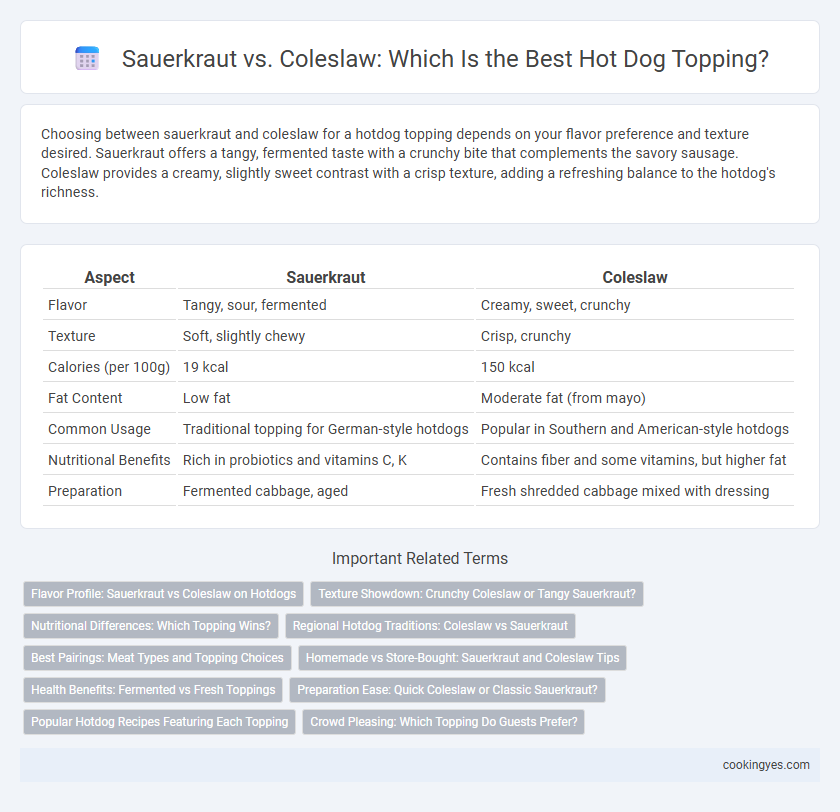Choosing between sauerkraut and coleslaw for a hotdog topping depends on your flavor preference and texture desired. Sauerkraut offers a tangy, fermented taste with a crunchy bite that complements the savory sausage. Coleslaw provides a creamy, slightly sweet contrast with a crisp texture, adding a refreshing balance to the hotdog's richness.
Table of Comparison
| Aspect | Sauerkraut | Coleslaw |
|---|---|---|
| Flavor | Tangy, sour, fermented | Creamy, sweet, crunchy |
| Texture | Soft, slightly chewy | Crisp, crunchy |
| Calories (per 100g) | 19 kcal | 150 kcal |
| Fat Content | Low fat | Moderate fat (from mayo) |
| Common Usage | Traditional topping for German-style hotdogs | Popular in Southern and American-style hotdogs |
| Nutritional Benefits | Rich in probiotics and vitamins C, K | Contains fiber and some vitamins, but higher fat |
| Preparation | Fermented cabbage, aged | Fresh shredded cabbage mixed with dressing |
Flavor Profile: Sauerkraut vs Coleslaw on Hotdogs
Sauerkraut offers a tangy, fermented flavor with a sharp acidity that cuts through the richness of a hotdog, providing a zesty contrast. Coleslaw delivers a creamy, slightly sweet taste with a crunchy texture, balancing the savory meat with its mild, refreshing flavor. Choosing between sauerkraut and coleslaw depends on whether a tangy, bold flavor or a creamy, sweet complement is preferred on the hotdog.
Texture Showdown: Crunchy Coleslaw or Tangy Sauerkraut?
Crunchy coleslaw provides a crisp texture that enhances the juicy bite of a hotdog, offering refreshing contrast with its creamy dressing and shredded cabbage. Tangy sauerkraut delivers a softer yet slightly chewy texture combined with a bold, fermented tang that complements the savory sausage flavor. Choosing between the two depends on whether you prefer the sharp bite and crispness of coleslaw or the mellow, zesty softness of sauerkraut as your perfect hotdog topping.
Nutritional Differences: Which Topping Wins?
Sauerkraut offers a low-calorie, probiotic-rich option packed with vitamin C and fiber, aiding digestion and supporting gut health, while coleslaw contains higher calories and fat due to mayonnaise but provides vitamin K, vitamin A, and antioxidants from cabbage and carrots. For those seeking a healthier hotdog topping, sauerkraut wins by delivering beneficial probiotics and fewer calories, making it ideal for weight-conscious consumers. Coleslaw may appeal more to those prioritizing vitamin intake and a creamy texture, but its higher fat content can impact overall nutritional balance.
Regional Hotdog Traditions: Coleslaw vs Sauerkraut
In regional hotdog traditions, sauerkraut is a classic topping predominantly favored in Chicago and New York City, offering a tangy, fermented flavor that complements the savory sausage. Coleslaw, with its creamy and slightly sweet profile, is especially popular in Southern states such as North Carolina and Alabama, where it adds a refreshing crunch to grilled hotdogs. These regional preferences highlight the cultural diversity of American hotdog customization, balancing acidity and texture according to local taste norms.
Best Pairings: Meat Types and Topping Choices
Sauerkraut pairs exceptionally well with smoked or grilled sausages like bratwurst and kielbasa, enhancing their savory and smoky flavors with its tangy and slightly sour profile. Coleslaw complements softer, milder hotdog varieties such as classic beef or chicken hotdogs, adding a creamy crunch that balances the meat's rich texture. Choosing between sauerkraut and coleslaw depends on the meat type, as sauerkraut intensifies bold, spiced sausages while coleslaw provides a refreshing contrast to traditional hotdog meats.
Homemade vs Store-Bought: Sauerkraut and Coleslaw Tips
Homemade sauerkraut offers a tangy, probiotic-rich topping for hotdogs, enhancing flavor and digestive health compared to store-bought versions that often contain preservatives and added sugars. Freshly made coleslaw provides crisp, vibrant textures and customizable seasoning using raw cabbage and carrots, while pre-packaged coleslaw can be overly creamy and less fresh. To achieve the best hotdog experience, homemade sauerkraut and coleslaw deliver superior taste, freshness, and nutritional benefits.
Health Benefits: Fermented vs Fresh Toppings
Sauerkraut, a fermented topping, offers probiotics that support gut health and boost digestion, making it a nourishing choice for hotdog enthusiasts. Coleslaw, made from fresh cabbage and carrots, provides essential vitamins like vitamin C and antioxidants that enhance immune function. While sauerkraut aids in balancing gut microbiota, coleslaw delivers fiber and low-calorie freshness, making both toppings beneficial based on dietary needs.
Preparation Ease: Quick Coleslaw or Classic Sauerkraut?
Coleslaw offers quick preparation with shredded cabbage mixed with mayonnaise, vinegar, and seasonings, making it a convenient topping for hotdogs. Classic sauerkraut requires fermentation, involving days of preparation to develop its signature tangy flavor, which can be time-consuming. For fast hotdog toppings, coleslaw's ease of assembly is ideal compared to the traditional, longer process of preparing sauerkraut.
Popular Hotdog Recipes Featuring Each Topping
Popular hotdog recipes featuring sauerkraut often highlight its tangy, fermented flavor, pairing perfectly with traditional German-style sausages like bratwurst. Coleslaw-topped hotdogs are staples in Southern and BBQ cuisine, offering a creamy, crunchy contrast that complements smoked or grilled hotdogs. Both toppings enhance the overall taste experience, with sauerkraut adding a sharp zest and coleslaw providing a sweet, refreshing crunch.
Crowd Pleasing: Which Topping Do Guests Prefer?
Sauerkraut offers a tangy, fermented crunch that enhances the savory flavor of hotdogs, often favored by fans of traditional, bold toppings. Coleslaw provides a creamy, slightly sweet contrast that complements the smoky, juicy hotdog, appealing to those who enjoy a milder, refreshing texture. Crowd preference generally leans toward coleslaw for its balance of flavors and creamy texture, making it a popular choice at casual barbecues and family gatherings.
Sauerkraut vs Coleslaw for hotdog topping Infographic

 cookingyes.com
cookingyes.com